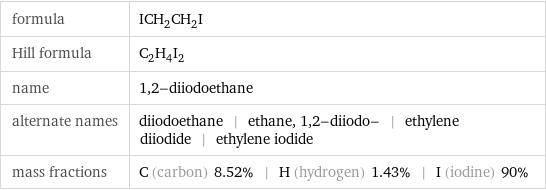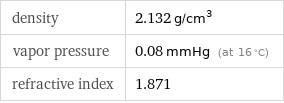Input interpretation

1, 2-diiodoethane
Chemical names and formulas

formula | ICH_2CH_2I Hill formula | C_2H_4I_2 name | 1, 2-diiodoethane alternate names | diiodoethane | ethane, 1, 2-diiodo- | ethylene diiodide | ethylene iodide mass fractions | C (carbon) 8.52% | H (hydrogen) 1.43% | I (iodine) 90%
Lewis structure

Draw the Lewis structure of 1, 2-diiodoethane. Start by drawing the overall structure of the molecule: Count the total valence electrons of the carbon (n_C, val = 4), hydrogen (n_H, val = 1), and iodine (n_I, val = 7) atoms: 2 n_C, val + 4 n_H, val + 2 n_I, val = 26 Calculate the number of electrons needed to completely fill the valence shells for carbon (n_C, full = 8), hydrogen (n_H, full = 2), and iodine (n_I, full = 8): 2 n_C, full + 4 n_H, full + 2 n_I, full = 40 Subtracting these two numbers shows that 40 - 26 = 14 bonding electrons are needed. Each bond has two electrons, so the above diagram has all the necessary bonds. There are 7 bonds and hence 14 bonding electrons in the diagram. Lastly, fill in the remaining unbonded electrons on each atom. In total, there remain 26 - 14 = 12 electrons left to draw: Answer: | |
3D structure

3D structure
Basic properties

molar mass | 281.863 g/mol phase | solid (at STP) melting point | 81 °C boiling point | 206 °C density | 2.132 g/cm^3 solubility in water | insoluble
Units

Solid properties (at STP)

density | 2.132 g/cm^3 vapor pressure | 0.08 mmHg (at 16 °C) refractive index | 1.871
Units

Thermodynamic properties

specific heat of formation Δ_fH° | gas | 0.2661 kJ/g | solid | 0.03299 kJ/g molar heat of formation Δ_fH° | gas | 75 kJ/mol | solid | 9.3 kJ/mol molar heat of vaporization | 49.8 kJ/mol | specific heat of vaporization | 0.177 kJ/g | molar heat of combustion | 1368 kJ/mol | specific heat of combustion | 4.853 kJ/g | molar heat of fusion | 14.2 kJ/mol | specific heat of fusion | 0.05038 kJ/g | (at STP)
Chemical identifiers

CAS number | 624-73-7 Beilstein number | 1730870 PubChem CID number | 12224 PubChem SID number | 24893381 SMILES identifier | C(CI)I InChI identifier | InChI=1/C2H4I2/c3-1-2-4/h1-2H2 MDL number | MFCD00001093
Safety properties

flash point | 101 °C